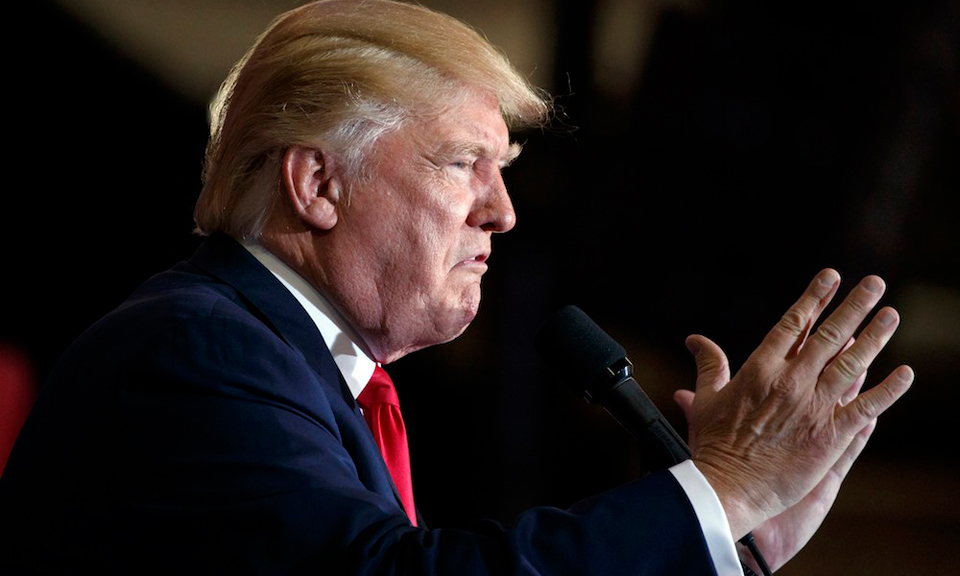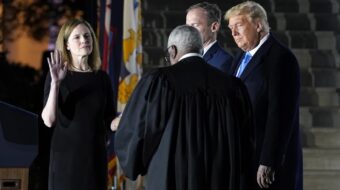
WASHINGTON – Union leaders blasted GOP President Donald Trump’s plan, unveiled June 21, to merge the Labor and Education Departments and – among other schemes – fully privatize the U.S. Postal Service.
But only one of those who issued statements, the Teachers’ Randi Weingarten, connected Trump’s scheme, unveiled by his radical right wing Office of Management and Budget chief, Mick Mulvaney, to the president’s wider war on workers.
“We’re extremely skeptical of the motivations here given how hostile” Education Secretary “Betsy DeVos and President Trump have been to public education, workers and unions,” Weingarten said.
“It seems like this move is just cover for continuing their agenda to go after public schools, gut civil rights and equity protections, provide support for predatory student loan companies and prey on workers. We strongly oppose this move, and Congress should reject it,” she declared.
Trump’s plan, contained in a 132-page document, calls for an enormous restructuring of domestic agencies while leaving the Defense Department virtually untouched, except to give it more responsibility. Other notable changes in the scheme include privatizing the Postal Service and selling off the Tennessee Valley Authority and other power administrations to private utilities.
The fate of Trump’s plan, which comes out of Trump-Mulvaney demands last year to agencies to turn over “reorganization” proposals, and to prepare for huge personnel cuts, is dubious. Privatizations have been goals of right-wingers and the corporate class for years.
They haven’t succeeded, or produced good results.
Republican President Richard Nixon’s huge government-wide reorganization, in 1970, merging all Cabinet departments into six super-departments, foundered on Capitol Hill. And Republican George W. Bush created the Department of Homeland Security, a monstrous agency with low morale, multiple missions and lots of controversy, most recently over Border Patrol and ICE roundups of immigrants and forced separation of kids from their parents.
Trump would combine DOL, one of the government’s largest enforcement agencies – policing everything from job safety and health to wage theft to ensuring federal contractors follow civil rights laws – with the Education Department, the smallest Cabinet department.
Copying the right wing ideology of the U.S. House’s ruling radical Republicans, Trump would rename the combination “Department of Education and the Workforce,” eliminating the word “Labor,” and its connotations of paying attention to workers, notably organized labor.
AFL-CIO President Richard Trumka called Trump’s scheme a “dangerous and bad idea that should be stopped. The core functions of these two departments — serving children and protecting working people — are critical tasks that require the individual attention each receives.
“Furthermore, the track record of the Trump administration attacking public education and worker safety and health calls serious question into the intentions of this proposal. Merging Education and Labor instead of the business-centric Commerce and Treasury Departments is another indication this is simply about increasing privatization and handing out more power to corporations at the expense of working people. The labor movement opposes this ill-conceived plan, and we call on Congress to defeat it.”
Communications Workers President Chris Shelton called Trump’s scheme “yet another attempt by the administration to weaken programs that serve and protect working families and to concentrate even more power in the hands of large corporations.”
“For over 100 years, the Department of Labor has had a unique and specific mission — to promote and develop the well-being of working people, to improve working conditions and workplace safety, and to enforce the laws that protect our rights in the workplace, including the right to join together to negotiate for better wages, benefits and working conditions.”
And the Education Department “is no less important” because it’s supposed to ensure equal access to education and that schools are free from discrimination, he added.
“The administration wants corporations to have more power over our lives. But children need a Department of Education that stands up for them. Working people need a Department of Labor that stands up for them. This radical plan would weaken both agencies, leaving working people and children more vulnerable to corporate abuses at work and in the education system. We urge Congress to reject this ill-conceived plan.”
Trump’s plan would be “disruptive, costly and do nothing to improve government services,” added Treasury Employees President Tony Reardon.
Government Employees (AFGE) President J. David Cox, who heads the largest federal workers union, was even more caustic. He said Trump is again showing his contempt for the nation’s two million federal workers, following three executive orders designed to weaken their workplace rights. AFGE, NTEU and 13 other unions are challenging those orders in court.
“There’s little reason to believe this reorganization plan is anything more than a scheme to eliminate essential programs and public-service jobs, reward or punish political appointees depending on their allegiance to the White House, and privatize government programs to reward political donors,” Cox said.
“We are particularly alarmed over proposals to privatize both the U.S. Postal Service and our federal air traffic control system.” But “most of this so-called reorganization plan, as reported in the media, targets domestic programs long unpopular with anti-government ideologues,” Cox added.
They include the Labor-Education merger, “removing the food stamp and school meal programs from USDA, and breaking up the personnel agency that administers federal employee background investigations, retirement claims and benefits, and employment policies.” Its functions would go to individual departments – or to White House insiders.
Letter Carriers (NALC) President Fredric Rolando was looking forward to working with Congress and the administration to modernize USPS and put it on a permanently sound financial footing by removing a 10-year-old GOP-passed $5 billion congressional mandate to prepay future retirees’ health care costs. That order technically puts USPS in the red every year, even as it makes money on first-class mail.
The Trump-Mulvaney recommendations scotched that outlook.
“The White House is making very clear that privatization of the Postal Service is its goal, despite the fact that the stakeholder meetings with the White House Postal Task Force are ongoing,” Rolando said. The only stakeholders who favor privatizing USPS, he added, are “private shippers, who would love nothing more than to see the Postal Service dismantled.”
“We were hopeful this administration was seeking real solutions to stabilize this agency with an 88 percent approval rating where veterans make up over 25 percent of its workforce. Now that we know this administration and its Task Force will make recommendations on reforms to achieve OMB’s privatization goals, NALC will work tirelessly with other stakeholders and Congress to oppose this faulty privatization plan every step of the way to preserve this public service,” Rolando concluded.
“Privatizing the Postal Service is not in the public interest and would be nothing more than a raid by corporate pirates on a national treasure,” added Postal Workers President Mark Dimondstein. Trump, he said, “delivered nothing but misinformation” to “end the delivery of regular mail and packages at an affordable cost to 157 million addresses every day.”
“Eliminating the universal service obligation, as the plan suggests, would hurt business and individuals alike,” Dimondstein added. “The public postal service serves each and every person and belongs to the people of this country.”
“The White House’s plan states, ‘Like many European nations the United States could privatize its postal operator…’ What’s left unsaid is European nations charge substantially more for mail services delivered in a much smaller area. They also regularly raise the cost of delivery…By comparison, the U.S. has the lowest postage rates in the industrialized world.”












Comments